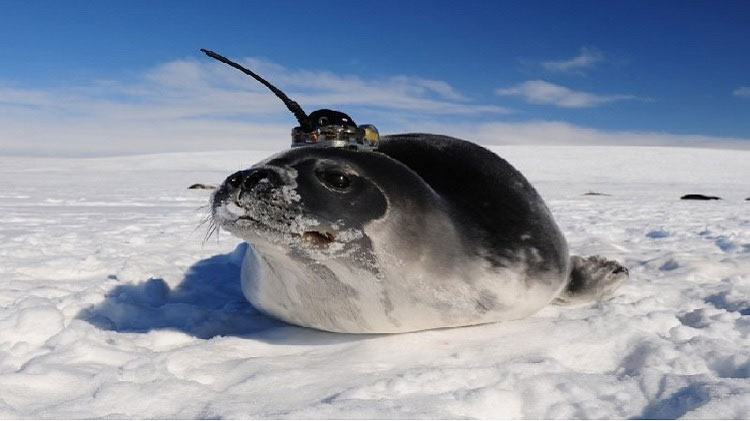Scientist decodes Antarctic ice holes
Conditions of erratic oceanic climate and a series of strong storms, salinity of sea water reaches the threshold . causing the water surface to not freeze.
Ice holes are called polynyas (sea areas that do not freeze in the ice block) , providing many benefits for Antarctic organisms. Seals, whales or penguins can swim around and rest in these pits. The image of the first ice holes appeared in 1974 in the Weddell Sea, which was as big as New Zealand. Then in 1975-1976, although the regional temperature was cold below freezing, after 1976, all the later ice holes disappeared.

Seals are fitted with GPS devices to collect data.(Photo: Dan Costa - University of California).
Oceanographer Ethan Campbell of the University of Washington once argued that large ice holes might be extinct. But in 2016, these ice holes appeared again, urging researchers to find answers. A study at the time suggested that ice holes were related to the activity of whirlwinds and sea breezes. However, this explanation is not enough, this phenomenon is not so simple.
Scientists have been based on SOCCOM data (Southern Ocean Carbon and Climate Observations and Modeling) since 2014. This device can analyze temperature, salinity and seawater flow at a depth of 2000 m. To gather more information, the Antarctic seal is equipped with a GPS device from Argos Systems to measure sea temperature and salinity sensors.
From the data collected, the scientists explained that, first of all due to erratic ocean climate conditions along with a series of strong storms dragged through. Secondly, when the salinity of the sea water reaches a high level like 2016, warm water from the bottom of the sea rises to the ice and is cooled when exposed to air. The warm water cycle prevents the ability to form ice, thus creating ice holes. Finally, the amount of carbon on the ocean floor due to climate change makes it difficult for seawater to accumulate into ice. The study was published in the journal Nature .
- Mysterious decoding of strange ice holes constantly appearing in Antarctica for decades
- Detecting signs of life in the bottom of the Antarctic lake
- Antarctic ozone holes are shrinking
- The person who discovered the ozone layer hole died
- The area of ice in Antarctica is mysteriously narrow
- Detecting two merging black holes in the universe
- Find the answer to Antarctic paradox
- Millions of black holes are hiding in our galaxy
- Decoding mistakenly thought that the black hole of the universe is
- The scientist struggled to cook at the extreme -70 degrees Celsius
- Elephant seals help study the Antarctic bottom
- Mysterious decoding of strange ice holes constantly appearing in Antarctica for decades
- Latest pictures of the Antarctic icy region
- Antarctic travel in winter
 'Fine laughs' - Scary and painful torture in ancient times
'Fine laughs' - Scary and painful torture in ancient times The sequence of numbers 142857 of the Egyptian pyramids is known as the strangest number in the world - Why?
The sequence of numbers 142857 of the Egyptian pyramids is known as the strangest number in the world - Why? History of the iron
History of the iron What is alum?
What is alum?